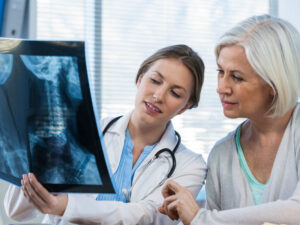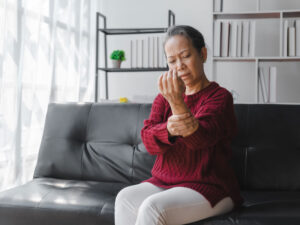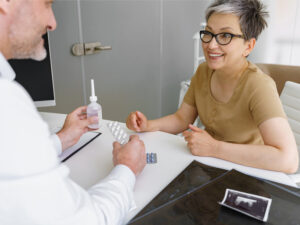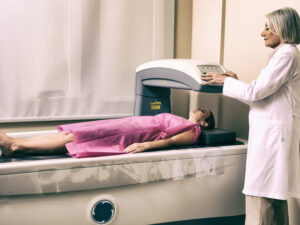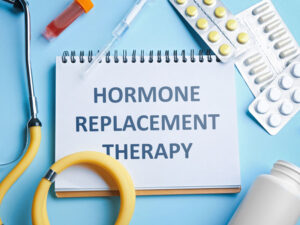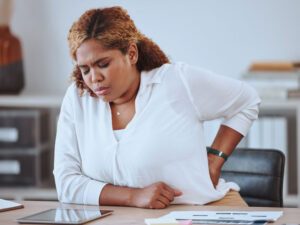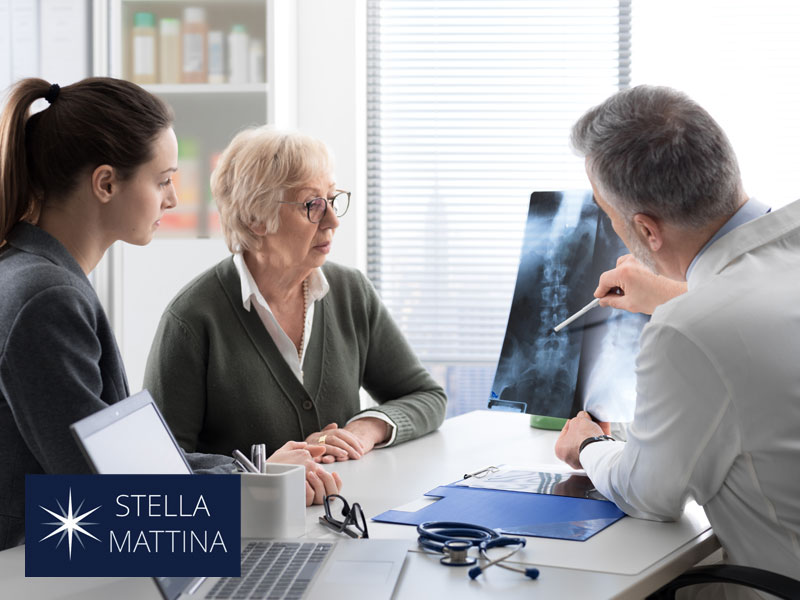
Did you know that approximately 10 million people have osteoporosis in the United States? And about 80% of these cases are women. Additionally, another 44 million people have low bone density, putting them at increased risk for developing osteoporosis.
Women, particularly those who are postmenopausal, are at a higher risk due to decreased estrogen levels, which play a crucial role in maintaining healthy bones.
Bone health is a real issue for aging women.
But if you suffer from this condition, this guide contains all the information you need to understand the causes, recognize potential symptoms, prevent fractures, and explore treatment options, including both traditional and bioidentical hormone therapy (HRT and BioTE) and bone-building medications.
Let’s start by understanding postmenopausal osteoporosis.
Table of Contents
What is Postmenopausal Osteoporosis?
Impact of Osteoporosis on Health
Potential Symptoms of Osteoporosis
Stages of Postmenopausal Osteoporosis
Postmenopausal Osteoporosis Treatment
BioTE Hormone Pellets For Treating Osteoporosis
How to Prevent Osteoporosis After Menopause
What is Postmenopausal Osteoporosis?
This condition primarily affects women after menopause, causing weakened bones and, eventually, fractures – due to decreased levels of estrogen.
With insufficient estrogen, you get bone resorption – a process where the bone is broken down and its minerals released into the bloodstream. When this outpaces bone formation, you get gradual loss of bone mass and strength.
Women who experience early menopause (before the age of 45) are at increased risk of developing osteoporosis, as they have more years of low estrogen levels. This accelerates bone density loss.
Impact of Osteoporosis on Health
Often called a “silent disease,” osteoporosis typically progresses without symptoms until a fracture occurs.
These fractures – most commonly in the hip, spine, or wrist – can have severe consequences for your health, including
- chronic pain,
- loss of mobility, and
- an increased risk of mortality, particularly in the case of hip fractures.
In addition to the physical impact, osteoporosis can bring emotional distress and decreased life quality as you fear fractures and potential loss of independence.
But don’t accept this as part of growing older. There’s hope available with hormone therapy, lifestyle adjustments, and osteoporosis medicines.
We’ll get back to these options soon. Before that, let’s examine potential symptoms and stages of osteoporosis so you can recognize osteoporosis as early as possible to get an effective treatment.
Potential Symptoms of Osteoporosis
Despite being referred to as a “silent” condition, there are potential symptoms that may indicate you’re at risk. Here are some warning signs:
Fractures from Minor Trauma
The most common and often the first sign of osteoporosis is a fracture from a fall or minor impact. As mentioned, the most common sites are hip, spine, and wrist.
Back Pain
Persistent or sudden-onset back pain may be a sign of a vertebral fracture or compression in the spine due to weakened bones.
Loss of Height
Over time, this may indicate osteoporosis. It may occur as a result of compression fractures in your spine, which collapse the vertebrae.
Stooped Posture
Also known as “dowager’s hump,” you get a noticeable curvature in your upper back. The hunched posture can be due to compression fractures in your spinal vertebrae.
Decreased Bone Density
Although this is not a physical symptom, a decrease in bone density can be detected through a bone mineral density (BMD) test, often before fractures or other symptoms occur.
For this reason, regular screenings and BMD tests are crucial for postmenopausal women.
Weakness and Fragility
Some postmenopausal women may experience a general feeling of weakness or frailty, particularly in their bones, which may indicate a decline in bone strength. If that’s you, talk to your doctor as soon as you start noticing this symptom.
Stages of Postmenopausal Osteoporosis
Osteoporosis progresses in five main stages, ranging from healthy bones and bone loss to more severe bone deterioration and fractures.
Your doctor will determine your bone health and the stage you’re in through a bone mineral density test. This gives a T-score. For reference, a T-score of -1.0 or higher (e.g., 0, -0.5) is considered normal.
Here’s what you can expect in each of the five stages:
1 Normal Bone Health
At this stage, bone mineral density is within the normal range (T-score -1.0 or higher), meaning your bones are still strong and healthy, with minimal risk of fractures.
2 Osteopenia
Your bone density is slightly below normal, but not low enough to be classified as osteoporosis. Your T-score is lower: between -1.0 and -2.5.
This stage is generally asymptomatic, but it’s a warning sign that bone loss has begun, and your risk of fractures is higher compared to normal bone density.
3 Early Osteoporosis
If your T-score has reached -2.5 or lower, that indicates your bone mass has decreased further, and even though there are still no outward symptoms, your bones are more fragile and prone to fractures.
4 Established or Advanced Osteoporosis
By now, you’ll have significantly reduced bone density, leading to very porous and brittle bones. Your T-score is -2.5 or lower and you’ll also experience visible signs such as loss of height, back pain, and a stooped posture. Fractures can also occur more easily, often from minimal impact.
5 Severe Osteoporosis
A T-score well below -2.5 combined with the presence of one or more fractures is classified as severe. You have extremely low bone mineral density. Your bones are very fragile, meaning that even everyday activities can lead to fractures.
You may feel severe and chronic pain, with pronounced height loss, and major deformities in posture. You’re also more likely to have frequent and possibly spontaneous fractures, including those that can result in significant disability or mortality.
Now that you understand postmenopausal osteoporosis and its symptoms and stages, let’s get to what matters – how to treat this condition.
Postmenopausal Osteoporosis Treatment
Treating osteoporosis is crucial for maintaining healthy bones, reducing the risk of fractures, and improving your quality of life. So, postmenopausal women who haven’t had any BMD test should ask their healthcare provider for one as soon as possible.
The earlier you start osteoporosis treatment, the better.
The primary goals of treatment are to strengthen bones, slow down bone loss, and manage symptoms.
Various treatment options are available, ranging from lifestyle changes and dietary supplements to medications and hormone therapies.
Some common osteoporosis drugs include:
- Bisphosphonates, which slow bone loss.
- Selective estrogen receptor modulators (SERMs), which mimic estrogen’s protective effects on your bones.
- Denosumab and parathyroid hormone analogs, which help build bone mass.
- Hormone therapy (traditional HRT or a bioidentical hormone therapy such as BioTE).
Estrogen and Calcium – the Perfect Match to Your Bones
Hormone replacement therapy (HRT) and bioidentical hormone replacement therapy (such as BioTE) are widely used approaches. This is especially so for women who are recently postmenopausal and already use hormone therapy to manage menopausal symptoms.
Hormone therapy – specifically estrogen therapy – starts replenishing estrogen levels. This helps relieve menopausal symptoms and plays a key role in maintaining bone mineral density.
If you’ve experienced early menopause, HRT is often recommended to help mitigate the risks of bone deterioration and other menopause-related health issues that may occur due to your longer experience of low estrogen levels.
In addition to hormone therapy, calcium and vitamin D supplementation, along with weight-bearing exercises, are also fundamental for treatment success. Together, they aim to reduce fracture risk and preserve your bone strength.
Now, let’s focus on the benefits of hormone therapy and learn the difference between HRT and BioTE.
Hormone Therapy for Treating Osteoporosis
Traditional hormone therapy is a cornerstone in the management of menopausal symptoms and osteoporosis, as it addresses the underlying hormonal imbalance that contributes to weakened bones.
Traditional HRT involves the administration of synthetic estrogen or a combination of estrogen and progesterone (combined HRT) to help maintain bone density and reduce the risk of fractures.
By compensating for the drop in hormone levels that occurs after menopause, HRT can help maintain stronger bones, and, in some cases, even improve your bone mineral density.
However, HRT is not without risks, as it may increase the risk of breast cancer, blood clots, and cardiovascular disease, so it’s typically recommended based on your overall health profile.
For this reason, a tailored approach to hormone replacement therapy has emerged as a good alternative for postmenopausal women who have increased risk factors for treatments that use synthetic hormones. This alternative is bioidentical hormone replacement therapy (BHRT).
BioTE Hormone Pellets For Treating Osteoporosis
BioTE is our preferred brand of BHRT at Stella Mattina. It’s an alternative approach to traditional hormone therapy to treat osteoporosis.
BioTE uses hormones extracted from plants that are chemically identical to those your body naturally produces. It’s a more natural form of hormone therapy.
Hormone therapy is designed to help replenish estrogen and other hormone levels, mitigating the bone loss that occurs after menopause.
BioTE comes in the form of compounded BioTE hormone pellets (pellet hormone therapy) customized to your specific needs.
BioTE Benefits and Considerations
The primary benefit of BioTE hormone therapy is its ability to closely mimic your body’s natural hormones if you’re experiencing postmenopausal osteoporosis.
BioTE can help slow bone loss, improve your bone density, and reduce the risk of fractures by restoring your estrogen levels in customized doses.
Ultimately, BioTE offers a promising and flexible option for postmenopausal women seeking a tailored approach to treat osteoporosis.
Best HRT for Osteoporosis
Menopausal hormone therapy, whether through traditional HRT or BioTE, plays a significant role in the prevention and treatment of osteoporosis.
However, the decision to use traditional or bioidentical hormone therapy should be made in consultation with your healthcare provider, considering your individual health history, risk factors, such as a history of breast cancer in the family, and personal preferences.
Like all hormone therapies, HRT and BioTE are not without risks and may not be suitable for everyone. Potential side effects, breast cancer risk, and the cost of treatment should all be considered when deciding which approach is best for you.
Now, let’s have a look at what you can do to prevent osteoporosis after menopause and improve bone health after 50.
How to Prevent Osteoporosis After Menopause
A decrease in estrogen levels accelerates bone loss and increases the risk of developing osteoporosis after 50, especially if you’ve already gone through menopause. So, maintaining strong and healthy bones becomes increasingly important.
Here are some strategies to help you prevent osteoporosis after menopause. They include dietary modifications, regular exercise, lifestyle changes, and proactive health monitoring.
Focus on Nutrition
Proper nutrition plays a key role in maintaining and building bone density. If you can’t have all the nutrients in your food sources, you should consider calcium and vitamin supplements.
You should prioritize the following nutrients to strengthen your bones:
- Calcium-Rich Foods: Foods high in calcium include dairy products like milk, cheese, and yogurt, as well as leafy green vegetables (e.g., kale, spinach), almonds, and calcium-fortified products like orange juice and plant-based milk.
- Vitamin D: Vitamin D helps your body absorb calcium. You can get vitamin D through sunlight exposure, foods like fatty fish (e.g., salmon, sardines), eggs, fortified cereals, and vitamin D supplements.
- Protein: Protein is important for bone structure. Maintain an adequate intake of lean proteins, such as poultry, fish, beans, and legumes, to support bone health.
- Magnesium and Vitamin K: These nutrients support calcium metabolism and bone strength. Foods like leafy greens, nuts, and seeds are excellent sources.
Engage in Regular Exercises
Exercise is one of the most effective ways to improve bone density and overall skeletal health in postmenopausal women. Try to practice some of the following activities regularly:
- Weight-bearing exercises
- Strength training
- Balance and flexibility exercises
Maintain a Healthy Body Weight
Being either underweight or overweight can negatively affect the health of your bones. Women with a low body weight may have lower bone mass and a higher risk of fractures – while being overweight can increase stress on bones and joints.
Avoid Harmful Habits
Certain lifestyle choices can contribute to bone loss and increase the risk of developing the condition. Here are some things to consider:
- Limit alcohol consumption
- Quit smoking
- Reduce caffeine
Regular Bone Mineral Density Screenings
Early detection of bone loss is crucial in preventing this disease. Postmenopausal women over 50 should have regular bone tests to monitor bone health. This allows for early intervention with lifestyle changes or treatments to keep your bones healthy.
Take Control of Postmenopausal Osteoporosis with Stella Mattina
Don’t risk allowing postmenopausal osteoporosis to dictate your future.
At Stella Mattina, we’re passionate about women’s health.
To receive personalized guidance and BioTE hormone therapy for osteoporosis, schedule an appointment today.
Dr. Krum is currently in practice in Arlington, TX. He received his undergraduate degree at Texas A&M University, then attended UTMB Galveston for medical school, finishing in 1986, completing his residency there in 1990. Providing a full range of obstetrical and gynecological care, he specializes in the treatment of endometriosis and robotic surgery. He arranges his schedule so that same-day appointments are usually available.

